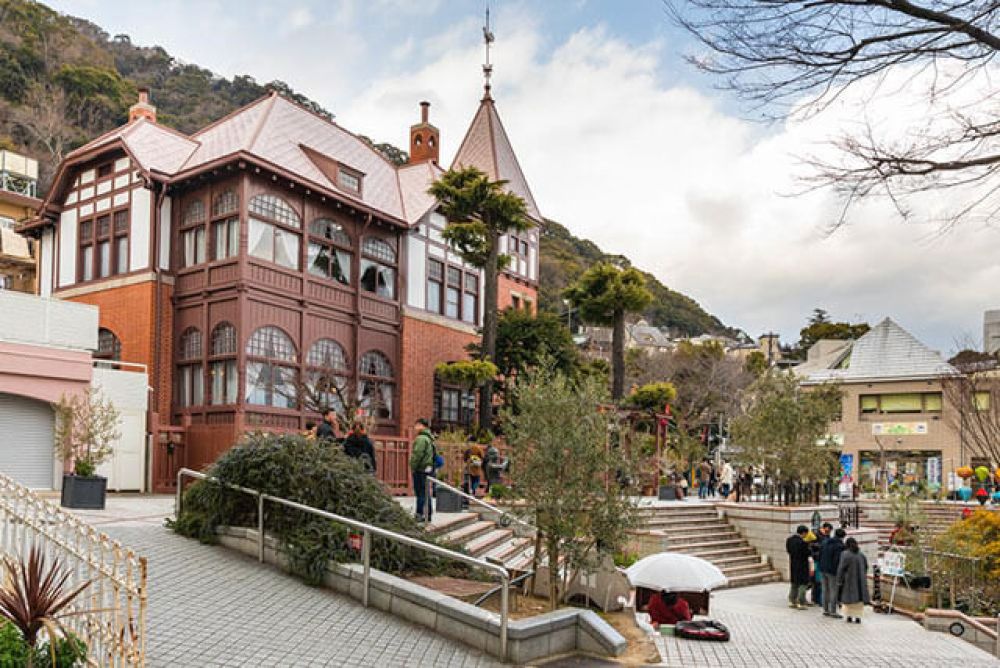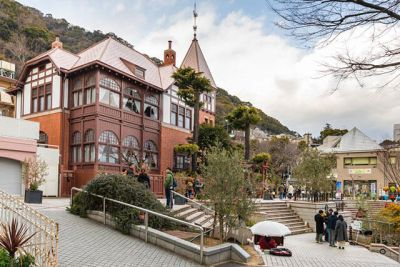

The Kitano Ijinkan are a set of historical buildings located in Kitano-cho, Kobe, which served as residences for foreign merchants and diplomats who settled in Kobe after the port was opened to foreign trade in the 19th century. Visitors can explore these well-preserved mansions, which showcase a unique blend of Western and Japanese architectural styles from the Meiji and Taisho periods. Each house features distinctive elements and antique furnishings that reflect the lifestyle of its former residents. You can take a leisurely stroll through the picturesque streets, enjoy the fusion of cultures, and perhaps stop at a café that often occupies one of the refurbished buildings. The experience is like stepping into a time capsule, providing a glimpse into the cosmopolitan history of Kobe and the Western influence in Japan during the period of rapid modernization.
The Kobe Kitano Museum, located at the heart of Kitano-cho, offers a comprehensive cultural experience through its various exhibitions of art, history, and artifacts related to Kobe's international heritage. Visitors have the opportunity to learn about the city's past, from its origins as a cosmopolitan port town to its development into a modern metropolis. The museum's collections include pieces from local artists, historical documents, and interactive displays that provide insight into the lives of the foreign settlers who once inhabited the area. Special temporary exhibitions are also held throughout the year, often focusing on specific aspects of Kobe's rich cultural tapestry or featuring contemporary art that resonates with the city's diverse influences. Spend time browsing the galleries, attending a workshop, or simply enjoying the ambiance of this educational and artistic enclave.
The Weathercock House, known locally as the Kazamidori no Yakata, is one of the most iconic foreign residences in Kitano-cho. This beautiful red-brick building, erected in 1909, was once the home of German trader G.Thomas. It is named after the weather vane on its spire, which is shaped like a rooster. The house is a prime example of German architecture from the time period, featuring intricate woodwork, stained-glass windows, and elegant furnishings. The interior has been restored and preserved meticulously, offering visitors a historical journey through the lifestyle of foreign residents in Kobe over a century ago. The Weathercock House is not just about the architecture; it also serves as a symbol of Kobe's openness to international influence and its resilience, having survived the Great Hanshin Earthquake in 1995.
Embark on a guided walking tour of Kitano-cho, the charming, cobblestoned district of Kobe known for its unique blend of Japanese and Western architectures. The tour provides an immersive experience of the rich history that shaped Kobe into the cosmopolitan city it is today. This picturesque neighborhood, located on the foothills of the Rokko Mountains, offers stunning views of the city and the port below. As you meander through the narrow streets, your knowledgeable guide will point out hidden gems and share anecdotes about the area's past. You'll see a variety of Ijinkan (foreign residences) that have been converted into museums, boutiques, and cafés, and learn about the different cultural influences that have left their mark on each structure. Don't miss the opportunity to delve into the stories behind these historical edifices while enjoying the serene and inviting atmosphere of Kitano-cho.
Moegi House is another fascinating Ijinkan in Kitano-cho, which once served as the residence of the American Consul General. Built in 1903, this eye-catching, two-story wooden structure is enveloped in a distinctive green color, from which it derives its name ('Moegi' means young green in Japanese). The architecture is an intriguing mix of Western and Japanese styles with clapboard exteriors, bay windows, and tatami rooms. Inside, visitors can find period furniture and historical photos that depict the lifestyle of the early 20th-century diplomats in Kobe. Touring Moegi House offers an intimate look at international relations during a pivotal time in Japan's history. It's not just a trip into the past; it's an exploration of the cross-cultural exchanges that continue to influence the city's identity today.
Nestled within the historic area of Kitano-cho, the Kobe Kitano Tenman Shrine offers a tranquil respite from the city's hustle and bustle. This Shinto shrine, established in the late Edo period, is dedicated to Sugawara Michizane, a scholar, poet, and politician revered as the god of learning. The shrine is a popular spot for students praying for success in exams. With its serene atmosphere, the shrine grounds provide a lovely place for contemplation and appreciation of traditional Japanese culture. As you enter, cleanse your hands and mouth at the chozuya (water ablution pavilion), then stroll through the peaceful precincts. Don't miss the chance to pick up an omikuji (fortune slip) or an ema (votive plaque) to write your wishes. Visiting the shrine allows for an enriching cultural experience and a moment of reflection amidst the heritage-rich surroundings of Kitano-cho.
Uroko House, also known as the 'House of Scales,' is yet another intriguing foreign residence in Kitano-cho. Distinctive for its scale-patterned exterior, the building combines Western and Japanese architectural elements. Built in 1902 for a German trading company's director, it has been transformed into Uroko's Museum. The museum features an exhibition of fine arts, including both Western and Japanese paintings and ceramics, giving visitors a taste of the cultural diversity that Kitano-cho is famous for. After exploring the art pieces on display, you can relax in the lovely garden cafe attached to the museum. The Uroko House also hosts tea ceremonies and special events that let you immerse yourself further into the cultural meld that characterizes Kitano-cho, making it more than just a historical site but a vibrant center of art and tradition.
Kitano Meister Garden is a unique establishment located in a refurbished elementary school in Kitano-cho. This creative space is now home to a variety of workshops, studios, and shops focusing on craftsmanship and design, from jewelry making to leather crafting and glass art. Visitors can participate in hands-on classes, watch artisans at work, or browse the collection of products made by local creatives. It's an excellent way to engage with the artistic community of Kobe and perhaps pick up a unique souvenir. The building itself is a fusion of Western and Japanese styles, reflecting the diverse history of the area. The garden provides a community hub where art, culture, and education intersect, offering a glimpse into Kobe's contemporary creative identity and its commitment to preserving and promoting local skills and traditions.
For those with a sweet tooth, the Kitano-cho Chocolate Factory presents a delightful experience. This small but charming factory allows visitors to learn about the chocolate-making process, from bean to bar. The tour guides you through the various stages of production, providing insight into the art of chocolatery with the chance to taste different types of chocolates. Some tours may include a chocolate-making workshop, where you can create your own custom confections to take home. The factory is a testament to Kobe's spirit of innovation and craftsmanship, with a focus on quality and flavor that reflects the city's gastronomic excellence. Whether you're a chocolate aficionate or simply looking for a fun activity, the Kitano-cho Chocolate Factory Tour promises to be a delicious and memorable part of your visit to Kobe.
While technically just above Kitano-cho, accessible by a short ropeway ride, the Kobe Nunobiki Herb Gardens provide an enchanting escape into nature with panoramic views of Kobe. As Japan's largest herb garden, it boasts over 200 varieties of herbs along with beautiful seasonal flowers, greenhouses, and themed gardens. You can immerIZE your senses in the fragrant scents and vibrant colors while learning about the uses and benefits of different herbs. The garden also features a restaurant serving herb-infused dishes and a shop where you can purchase a wide range of herbal products. A walk around Kobe Nunobiki Herb Gardens is not just a visual feast but also a therapeutic experience. The garden paths lead visitors down the southern slopes of Mount Rokko, showcasing the harmonious blend of natural beauty with the city's cultivated sophistication.
